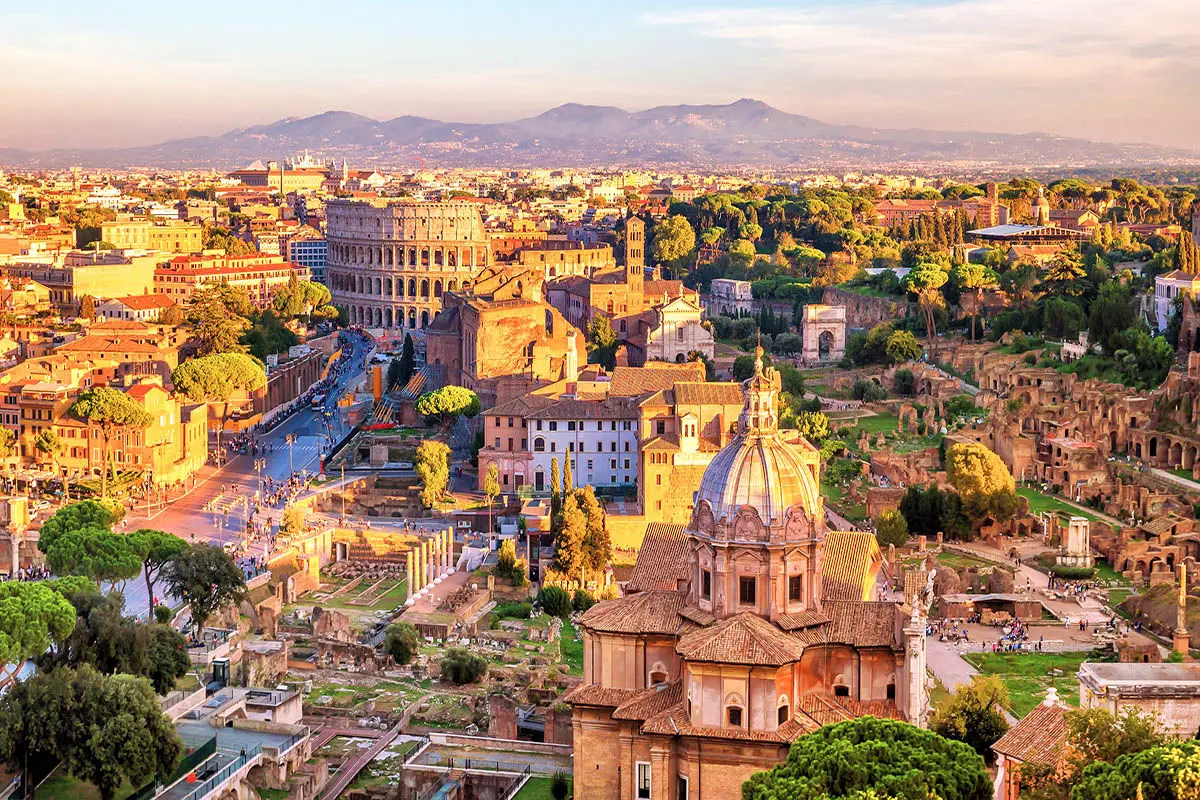
THE COLOSSEUM OF ROME
The audioguide (audioguides) starts at the Colosseum, which is symbolic to Rome. Entering its gates takes you back 2,000 years to the most majestic and splendid era of the Roman Empire.
Under the motto "Pan et Circus", the Roman Colosseum, which was initially known as the Flavio Amphitheater, allowed more than 50,000 people to enjoy spectacles such as war recreations, exotic animal displays, prisoner executions and gladiatorial battles to the death.
Its construction began in 72 AD under the rule of Emperor Vespasian and ended in 80 AD during the mandate of Emperor Tito. Tito inaugurated the edifice with 100 days of lavish games which cost the lives of over 2,000 gladiators.
The Colosseum became the largest amphitheater of the empire. It featured a canvas roof to protect the public from the sun, while machinery and cages were buried under the sand.
The original title of the "Flavian Amphitheatre" was replaced by the Colosseum to honor the great statue of Nero, "The Colossus of Nero." The statue was located at the entrance of the Domus Aurea, a palace built under the orders of Nero after the fire of Rome.
The Colosseum remained in use for more than 500 years. Its last games were held in the 6th century.
The Pope currently presides over the Way of the Cross every Good Friday. The Colosseum has always been closely tied to the church, and on this day, the first Christians who died in the sand are remembered.
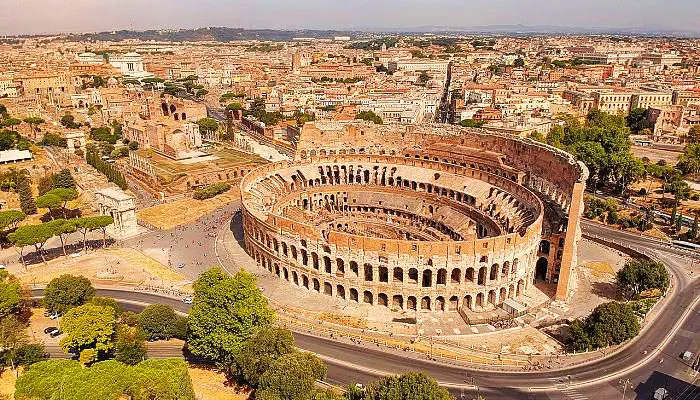
THE ROMAN FORUM
The forum was where the cultural, public and economic life of the republic and empire era developed.
The area in which the forum is located was originally a marsh. In the 6th century BC it was drained via the construction of the Cloaca Máxima, one of the earliest sewer systems in the world.
There are many temples within the Forum (Saturn, Venus, Romulus, Vesta, etc). From the Palatine and Plaza del Campidoglio, one can appreciate the forum from unique perspectives with the audioguide (audioguides).
At the end of the Empire, it was left to decay. It wasn’t until the twentieth century when the first excavations were made.
It also houses:
The Sacred Road: The Main street of ancient Rome which connected the Plaza del Campidoglio with the Colosseum.
The Arch of Titus: A triumphal arch that commemorates the victory of Rome over Jerusalem. It was built after the death of Emperor Titus.
The Septimius Severus Arch, which honors the emperor of the same name.
The Antoninus and Faustina Temple, which was built in the second century.
The Basilica of Maxentius and Constantine, which was one of the largest buildings of the Roman Forum.
The Curia: The building in which the Senate would meet.
The Column of Phocas, which was erected in the year 608 AD in honor of the Emperor of Byzantium. At 13 meters high, it is one of few that remains standing.
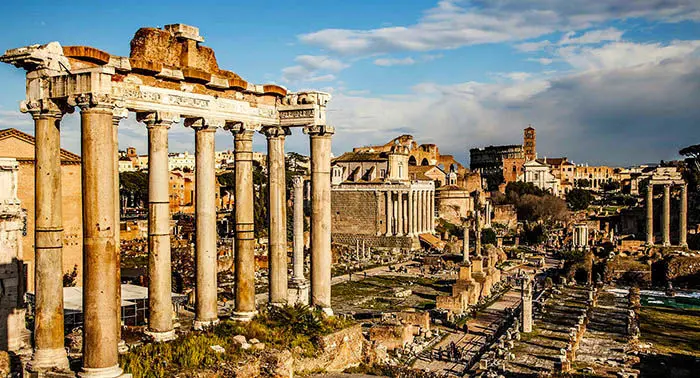
THE TREVI FOUNTAIN
Next stop of our audioguide (audioguides), the Trevi Fountain is the largest and most famous fountain in Rome. Its origin goes back to 19 BC when it served as the end point of the Aqua Virgo aqueduct.
Much later, during the Renaissance, Pope Nicolás V ordered the first fountain to be built. However, the final form which we can see today, dates from 1762 and was the work of Nicola Salvi and Giuseppe Pannini.
The name Trevi derives from Tre Vie (three tracks), because it was the point where three streets met.
The custom of throwing coins into the water with the right hand over the left shoulder came from the 1954 movie "Three Coins in the Fountain," which says the following:
If you toss one coin, you'll come back to Rome.
If you toss two coins, you’ll find love with an attractive Italian.
If you toss three coins, you’ll marry that person.
Every year about one million euros are removed from the fountain and donated to charity.
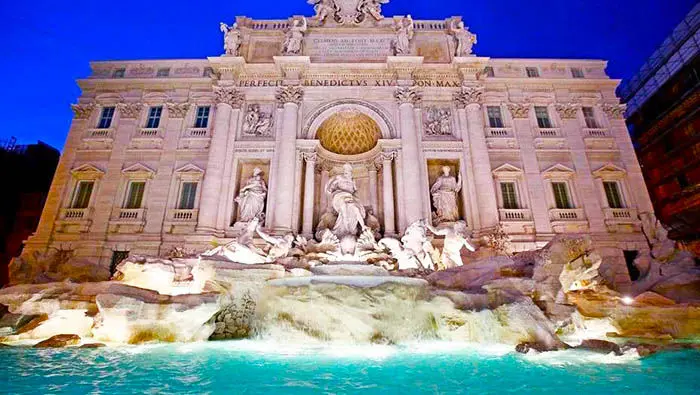
PIAZZA NAVONA
Built in the Baroque style with its three large central fountains, Piazza Navona occupies the land where the Domitian stadium or Agonal Circus was built in 86 AD. It had space for more than 30,000 spectators and hosted the Greek athletic games.
Built under the rule of Gregorio XIII Boncompagni, it is home to three important fountains: the Fountain of the Four Rivers, the Moor Fountain, and the Fountain of Neptune.
The "Fountain of the Four Rivers" was constructed by Bernini in 1651. The four statues of the fountain represent the four most important rivers of the time: the Nile, the Danube, the Ganges, and the Río de la Plata. In the center is an obelisk that belonged to the Circus of Maxentius, which was found on the Appian Way.
The Moor Fountain, formerly known as the "Snail Fountain," is located in the southern part of the plaza. It was created by Giacomo della Porta and perfected by Bernini who added the dolphins.
The Fountain of Neptune was designed by Giacomo della Porta. It remained unfinished until 1873 when the work was completed by Zappalà and Della Bitta.
Until the middle of the 19th century, the drains of the three fountains were closed each summer to flood the central part of the square which would become the Lake of Piazza Navona.
The square is home to the Palazzo Pamphili and the Church of Santa Agnes that you can see with the audioguide (audioguides).
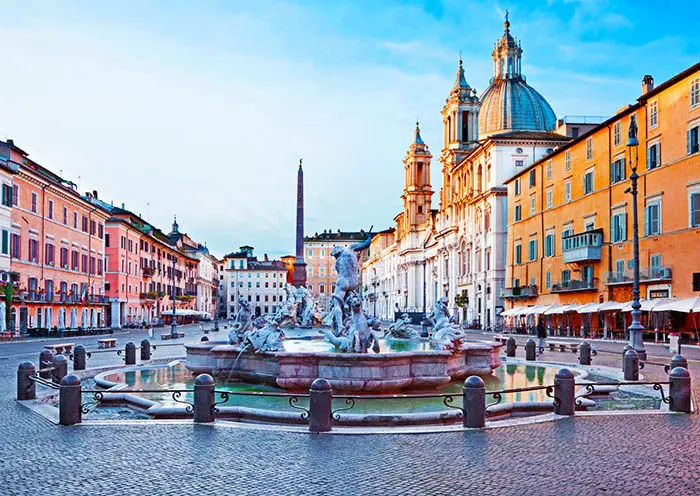
THE AGRIPA PANTHEON
The Agrippa Pantheon, more commonly known as the Pantheon, is the best preserved architectural work of ancient Rome. It was built during the time of Adriano in 126 AD and is open for the public to visit.
The spot where the current building is standing was previously occupied by the Pantheon of Agrippa, which was built in 27 BC and destroyed by a fire in 80 AD.
At the beginning of the 7th century, the building was donated to Pope Boniface IV, who transformed it into a church.
Perhaps most surprising are its measurements. The circular building has exactly the same diameter and height: 43.30 meters. The dome, which also has the same diameter, is larger than that of St Peter’s Basilica. In the center of the dome, an oculus with a diameter of 8.92 meters opens up to allow natural light to illuminate the entire building.
The rectangular facade, which hides the huge dome, is composed of 16 granite columns on which the following inscription can be seen, "M.AGRIPPA.L.F.COS.TERTIVM.FECIT.” In English, this means "Marco Agrippa, son of Lucio, consulate for the third time, built this."
Inside the Pantheon, with the audioguide (audioguides) you can see numerous works of art as well as the tombs of Italian kings and prominent citizens such as the Renaissance painter and architect Rafael.
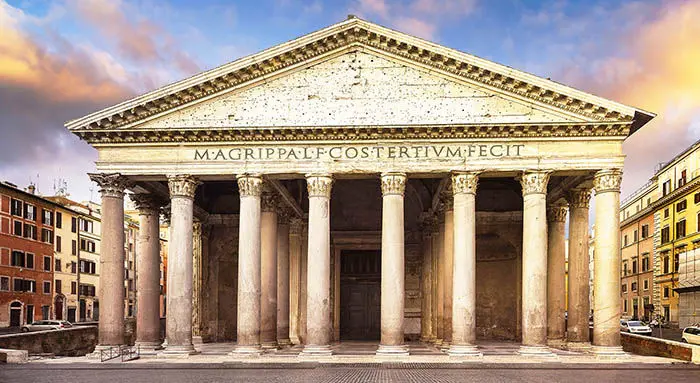
PIAZZA DI SPAGNA
The plaza has hosted the seat of the Embassy of Spain among Holy See since the 17th century, hence the name (The Spanish Plaza).
The 135 step high Spanish Steps, which were built at the beginning of the 18th century to connect the square with the Church of Trinità dei Monti, are world famous. These have been the scene of numerous films and fashion shows such as the Donne Sotto le Stelle, which sees big industry names put on a lavish show in mid-July.
Located in the center of the square, The Fontana della Barcaccia fountain is shaped like a ship and features engravings of the Bernini family emblems; the sun and the bees. It was designed by Pietro Bernini for Pope Urban III, and construction was completed in 1627 by his famous son, Gian Lorenzo Bernini.
Walking with the audioguide (audioguides) along the Via del Babuino towards Plaza del Popolo is the Flaminio, a 24-meter obelisk that once adorned the Circus Maximus. Up its stairs, you can access the viewpoint of La Terraza del Pincio.
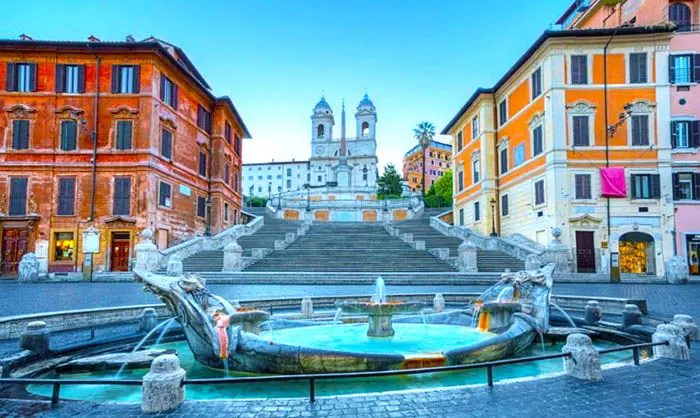
SAINT PETER’S SQUARE
Located in the Vatican at the foot of the St. Peter's Basilica, St. Peter's Square was built by Bernini in the mid-seventeenth century with the support of Pope Alexander VII.
The square has hosted more than 300,000 people during its most important liturgies and events.
It has 284 columns and 88 pilasters that line the plaza in a four-row portico. At the top of the columns are 140 statues of saints that were sculpted in 1670 by the disciples of Bernini.
In the center of the square stands a 25-meter high obelisk, which was brought to Rome from Egypt in 1586. The two fountains were built later, one by Bernini and the other by Maderno.
You can enter the Basilica to listen to the next audioguide (audioguides).
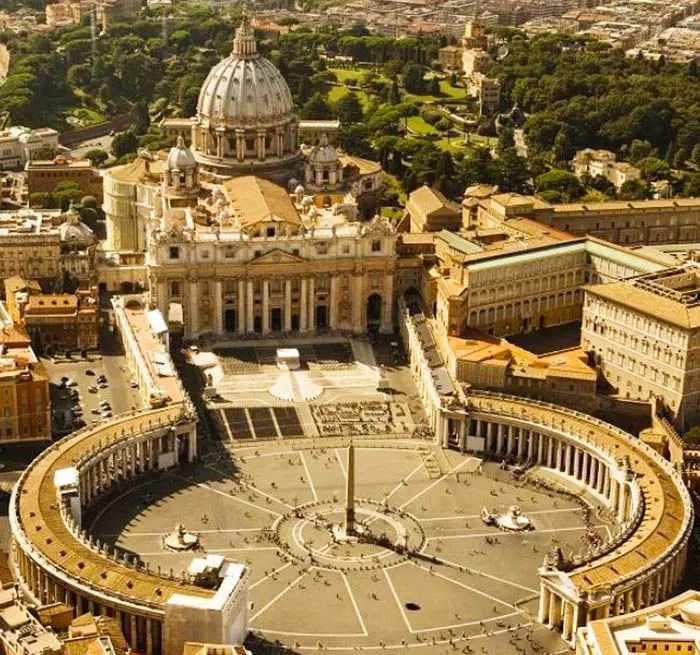
SAINT PETER'S BASILICA
St. Peter's Basilica is Catholicism’s most important building. Within it, the Pope celebrates the most significant liturgies.
Its construction began in 1506 and ended 120 years later in 1626, being consecrated that same year. The process involved prominent architects such as Bramante, Michelangelo and Carlo Maderno. It has a capacity for 20,000 people.
The name comes from the historical pope, Saint Peter, whose body is buried in the Basilica.
Among the works of art inside are Bernini's Baldacchino, Michelangelo’s Pieta, and a statue of Saint Peter on his throne, whose right foot has been partially worn away by the kisses of the devout.
Michelangelo began the construction of his imposing dome, Giacomo Della Porta continued the work, and Carlo Maderno finished it in 1614. The piece has been an inspiration for later projects such as St. Paul’s Cathedral in London and the Capitol Building in Washington. It is recommended to climb to the top of the dome with the audioguide (audioguides).
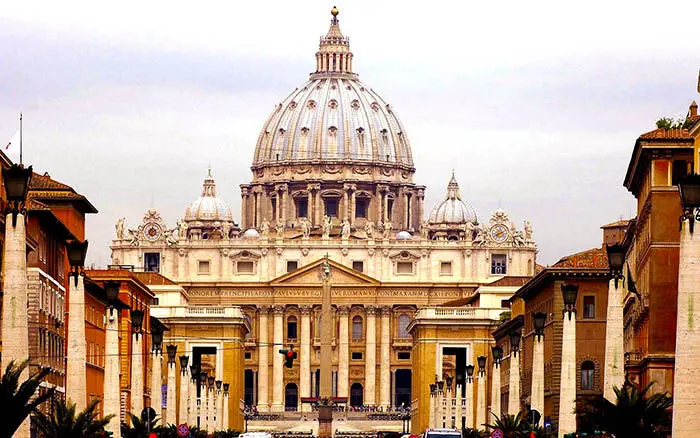
THE SISTINE CHAPEL
The Sistine Chapel is one of the greatest treasures of the Vatican. Within it, you can see with the audioguide (audioguides) the masterpieces of Michelangelo: The Creation of Adam and The Last Judgment. In addition, it is the temple in which the popes are elected and crowned.
Its construction took place between 1473 and 1481 during the mandate of Pope Sixtus IV, to whom it owes its name. The architect was Giovanni de Dolci.
The frescoes, which completely cover the walls and ceiling, were done by artists such as Botticelli, Perugino, Luca and Michelangelo.
All the ceiling frescoes are the work of Michelangelo, who spent four years painting the vault.
The nine stories of Genesis that occupy the central section are a highlight of the ceiling. These range from the Drunkenness of Noah to the Separation of the Light from Darkness. The Creation of Adam is undoubtedly the most well-known image of the entire fresco.
On the main altar is Michelangelo’s other masterpiece, The Final Judgment. The artwork represents the Apocalypse according to St. John and has dimensions of 13.7 by 12.2 meters.
Decorating the apse took Michelangelo five long years until he finally finished it in 1541. It was commissioned by Clement VII to cover the murals that existed until then.
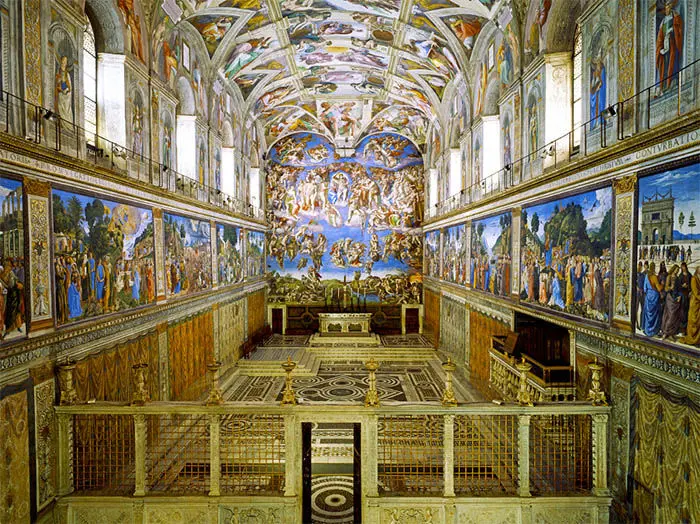
THE VATICAN MUSEUMS
Inside you can find thousands of artworks collected by the Roman Catholic Church over a period of more than five centuries.
These museums date back to 1503 when the newly appointed Pope Julius II donated his private collection. Since then, individual families and later popes have been adding to the museum’s collection which has led it to become one of the largest in the world.
The museums you can visit with the audioguide (audioguides) are:
The Pio Clementino Museum
The Gallery of the Candelabra
The Missionary Ethnological Museum
The Gallery of Maps
The Carriage Pavilion Historical Museum
The Gallery of Tapestries
The Pio Cristiano Museum
The Immaculate Conception and Sobieski Room
The Gregorian Egyptian Museum
The Etruscan Museum
The Chiaramonti Museum
The Profane Museum
The Borgia Apartments
The Raphael Rooms
The Hall of the Chariot
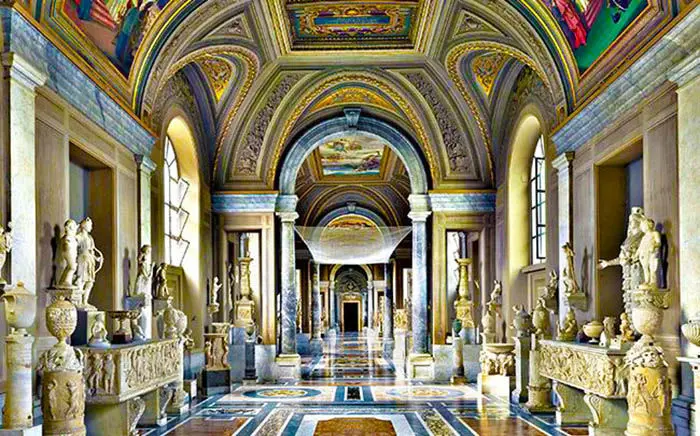
CASTLE SANT’ANGELO
Next point of the audioguide (audioguides), the Castle Sant’Angelo is a military fortress located on the right bank of the Tiber River. The complex is also known as Hadrian's Mausoleum because it was built by the emperor of the same name in 135. In 403, it was integrated into the Aurelian Wall.
In 590, during a great plague epidemic which devastated the city, Pope Gregory I had a vision of the Archangel Saint Michael announcing the end of the epidemic. The building is honoured by a statue of an angel in memory of the apparition.
In 1277 an 800-meter fortified corridor was constructed which connected the castle to Vatican City so that the Pope could escape if he were in danger. Clement VII later used the route during the sieges of Rome in 1527.
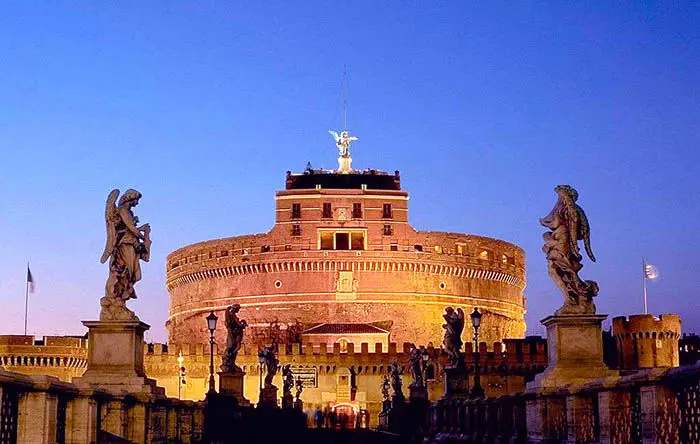
ARA PACIS
The Ara Pacis is a commemorative monument which was erected between 13 and 9 BC to celebrate peace in the Mediterranean after the victory of Emperor Augustus in Spain and Gaul. For this reason, it features numerous reliefs which display Augusto's family in procession, as well as different allegories related to the mythical foundation of Rome.
The carrara marble alter held yearly sacrifices of a ram and two oxen in honor of the goddess of Peace, to whom it is dedicated.
The shadow of the great obelisk, which is located in the Campus Martius, was projected onto the Ara Pacis on the day of Augusto's birthday.
Let's follow the audioguide (audioguides) to discover the Villa Borghese.
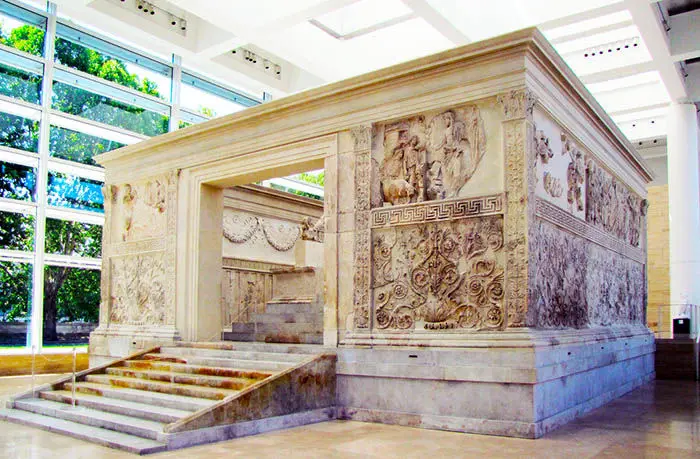
VILLA BORGHESE
The Villa Borghese in Rome is one of the largest urban parks in Europe. The state acquired the gardens from the Borghese family in 1901.
The park is a fusion between nature and the art of Rome. Throughout its gardens, you can see with the audioguide (audioguides) the buildings, sculptures, monuments, and fountains of famous artists from different eras, such as the Pincio Water Clock which is a marvel of 19th-century engineering.
Within the complex is the Borghese Gallery which houses paintings by artists such as Raphael, Titian, Caravaggio, Rubens, Botticelli or Bernini. The gallery exhibits a large part of the collection which Cardinal Scipione Borghese began between 1576 and 1633. He was the nephew of Pope Paul V and Bernini's first patron.
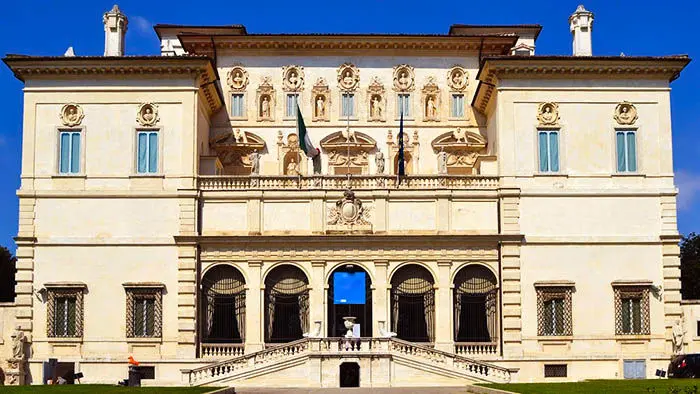
CAMPO DE' FIORI
Plaza Campo dei Fiori was built in 1456 on top of a field of flowers by order of Pope Calixto III.
It housed craft workshops and lodgings, while horse markets were held twice a week.
Public executions also took place here, a fact demonstrated by the 1889 statue of Giordano Bruno. The philosopher was burnt alive in the square in 1600 after being accused of heresy.
These days, the square hosts a daily market full of flowers, food, and handicrafts, that you can enjoy with the audioguide (audioguides).
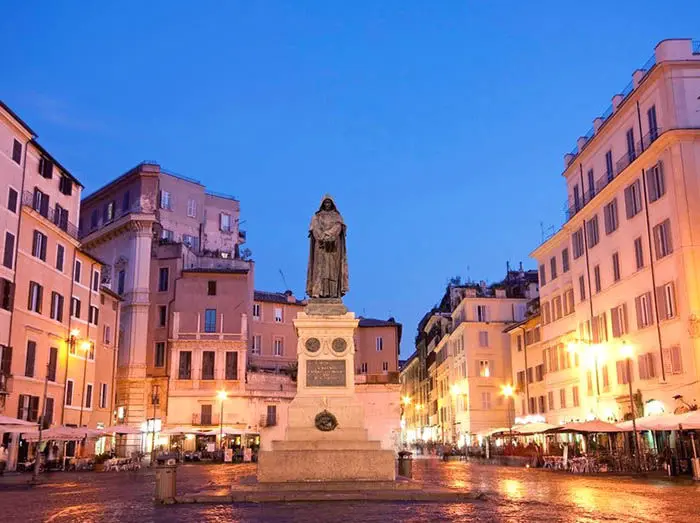
THE SACRED AREA
Next stop of our audioguide (audioguides), the Sacred Area is home to the ruins of the oldest temples in Rome and was discovered in 1926. The space was previously occupied by four different 3rd century temples as well as the Pompeyo theater and curia, where Julio César was murdered.
Hundreds of cats have decided to make it their home ever since the first excavations were made.
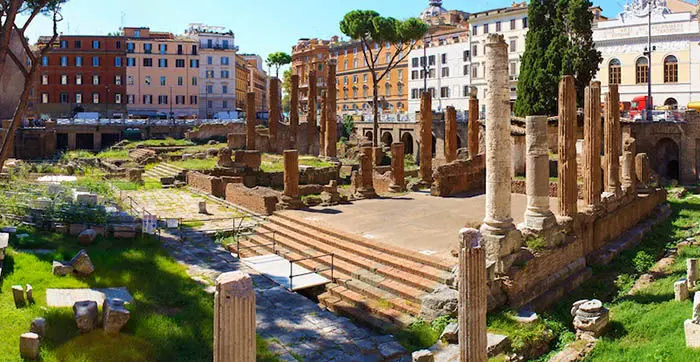
TRAJAN’S MARKET
Built out of brick between the years 100 and 110, Trajan's Market is the first covered shopping center in history. It originally consisted of six floors which contained more than 150 stores. At present, it still retains much of its original appearance.
It houses the Museum of the Imperial Forums which date back to the classical Roman era.
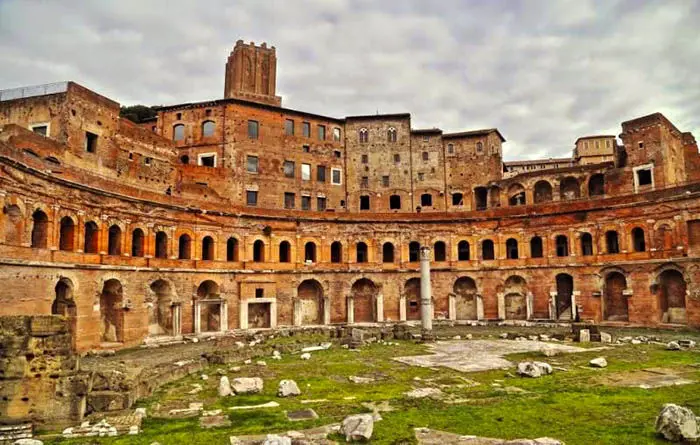
MONUMENT TO VICTOR MANUEL II
The Monument to Victor Manuel II was inaugurated in 1911 to pay homage to Vittoriano Emmanuel II, the Italian first king after unification.
Since 1921, it has housed the tomb of the Unknown Soldier and the eternal flame. It is always guarded by two soldiers.
With the audioguide (audioguides), notice that the tomb features Corinthian columns and white marble staircases. A bronze equestrian sculpture by Victor Manuel presides over the group and two guided chariots of the goddess Victoria crown the portico.
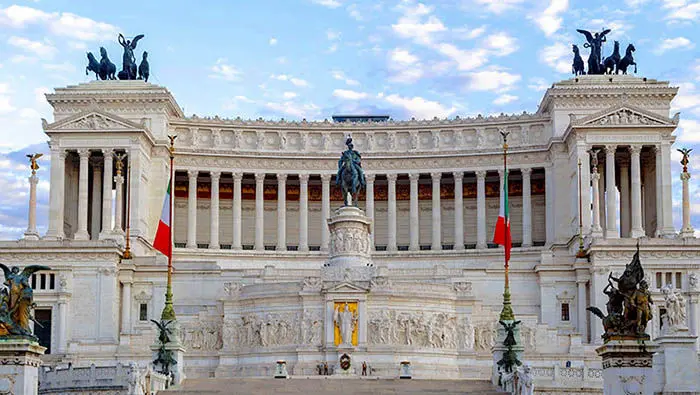
THE CAPITOLINE MUSEUMS
The Capitoline Museums are located in two palaces on Plaza del Campidoglio and constitute the main municipal museum of Rome. Both buildings are connected through the Lapidary Galleria, an underground passage that crosses beneath the plaza.
Its first bronze collection was ceded by Pope Sixtus IV in 1471, making this one of the oldest museums in the world.
In the Palazzo dei Conservatori is the original figure of the Capitoline Wolf as well as the first sculpted portrait of a living person, Ritratto di Carlo I d'Angiò, from 1277.
In the new palace is the Capitoline Venus, a marble sculpture made between 100 and 150 AD, the Discobolus, and an image of the dying Galata, among other works of art that you can see with the audioguide (audioguides).
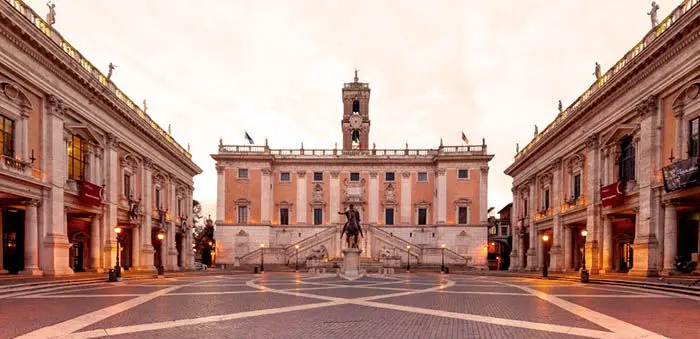
ARCH OF CONSTANTINE
The Arch of Constantine was erected in 315 in commemoration of the victory of Constantine I the Great at the Battle of the Milvian Bridge. It is located between the Colosseum and the Palatine Hill.
The arch was built from pieces of older buildings and was the last to be erected in ancient Rome.
Within it, you can see with the audioguide (audioguides) statues taken from the Forum of Trajan, some reliefs in which Marco Aurelio appears distributing bread among the poor, and a representation of Trajan after his victory against the Dacians.
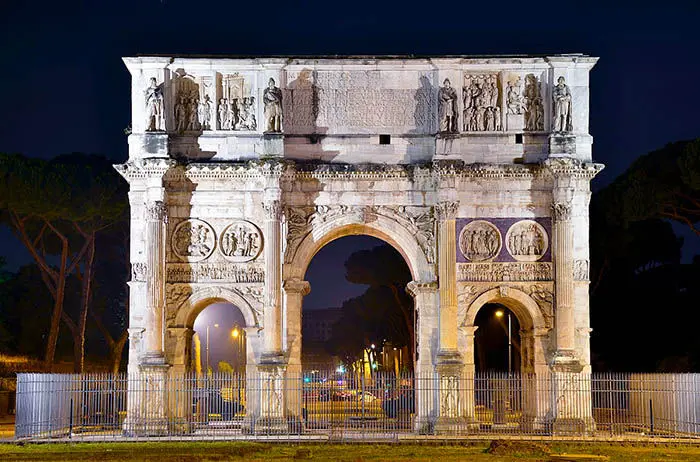
SAN PIETRO IN VINCOLI (SAINT PETER IN CHAINS) BASILICA
The San Pietro Basilica was built in the 5th century to house the chains which imprisoned Saint Peter in Jerusalem. These can be found with the audioguide (audioguides) in the reliquary under the high altar.
It is believed that Empress Eudoxia gave Pope Leo I one of the chains. According to legend, the other was also brought to Rome, and a miracle brought the two back together again.
It also houses the mausoleum of Pope Julius II, which features Michelangelo’s statues of Moses which he made between 1505 and 1515.
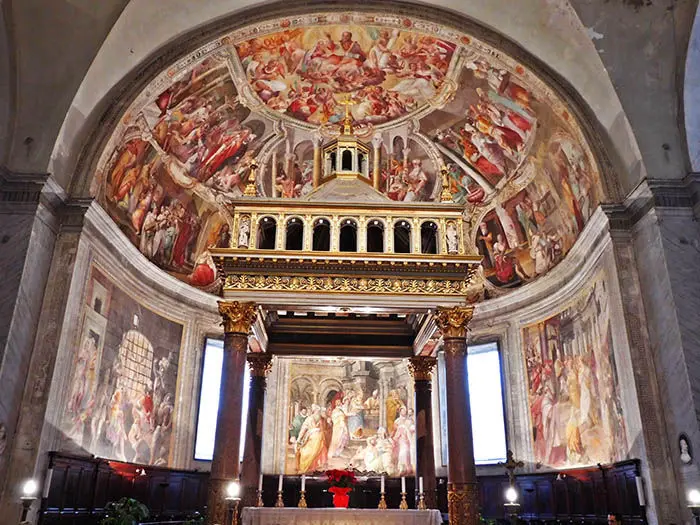
THE BASILICA DI PAPALE DI SANTA MARIA MAGGIORE
Next stop of this audioguide (audioguides), this church was built in the middle of the 4th century on a pagan temple that worshiped the goddess Cybele under the orders of Pope Liberius. According to legend, the Virgin appeared before the Pope to tell him to build the church, the shape of which was laid out by a miraculous snowfall.
The Church of Santa Maria Maggiore is the largest of the 26 churches in Rome dedicated to the Virgin Mary. It has also been called Our Lady of the Snow and Santa María Liberiana by Pope Liberius, and Santa Mary of the Crib for housing a relic of the Holy Crib.
The basilica has architectural styles from the Early Christian to the Baroque. It still has some ionic columns from the era of ancient Rome as well as a bell tower, mosaics and marble floors from the medieval period.
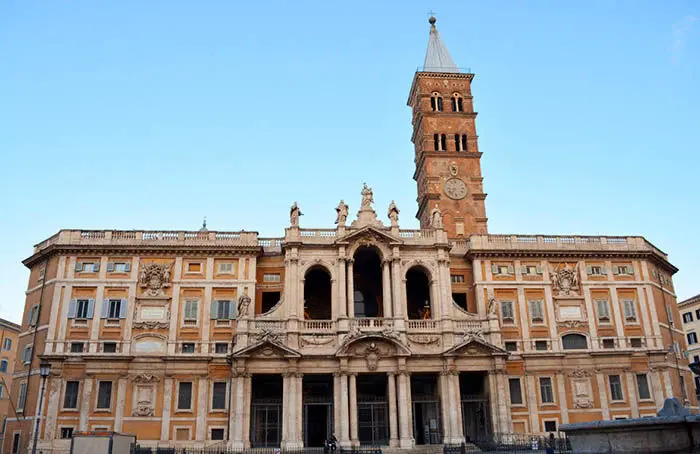
BASILICA SAINT JOHN LATERAN
Built in honor of Saint John the Baptist by Emperor Constantine the Great in the 4th century, this cathedral was the first church to be constructed in Rome.
At the beginning of the 4th century, Emperor Constantine stripped the Laterani family of their land in order to construct the first Roman basilica.
Until 1870, all the Pontiffs were invested in it. The pope, as bishop of Rome, continues to celebrate Holy Thursday inside.
The central bronze doors are the original ones from the Roman Curia, which is located in the Imperial Forums.
In front of the basilica, with the audioguide (audioguides) you can find the Holy Stairs, which Jesus Christ climbed for judgement on Good Friday. These were taken from the palace of Pontius Pilate in the year 326.
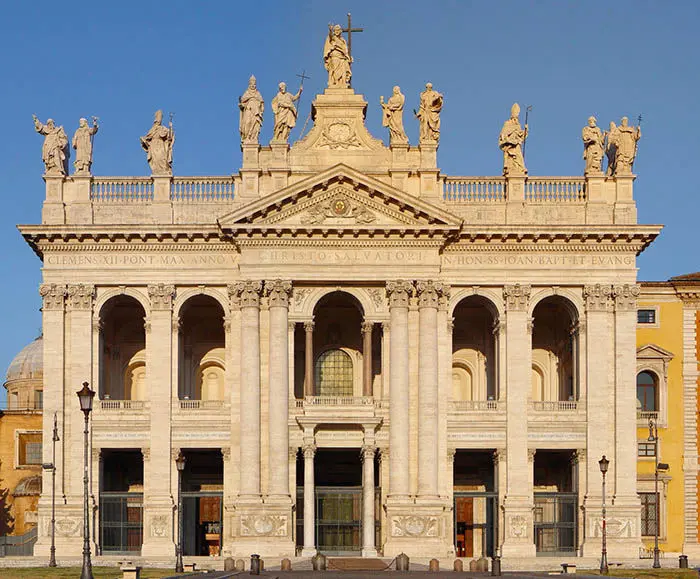
THE PALATINE HILL
The Palatine Hill is located 40 meters above the Roman Forum and is the most central of the seven hills of Rome.
Roman mythology dictates Luperca’s cave, the wolf that looked after Rómulo and Remo, was located here. When the brothers grew up, they decided to create a city on the banks of the river. However, Rómulo killed Remo after an argument and founded the city of Rome.
Inhabited since 1000 BC, has been the residence of the Roman high society. During the Republican period, sumptuous palaces were built here, vestiges of which still remain today and are visitable with the audioguide (audioguides). Highlights include the Domus Flavia, the House of Livia and the House of Augustus.
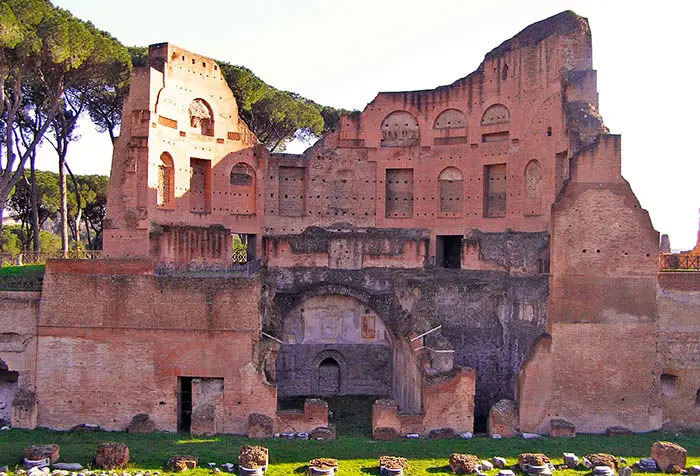
THE MOUTH OF TRUTH
Next stop of the audioguide (audioguides), the Mouth of Truth is a massive marble mask that is said to bite the hands of those who are lying.
It is dedicated to the God of the Sea, who is represented by a male face with a beard and pierced eyebrows, nose, and mouth.
The sculpture was located in the Plaza de la Bocca della Veritá until 1632 when it was moved to the exterior of the Church of Santa María in Cosmedin.
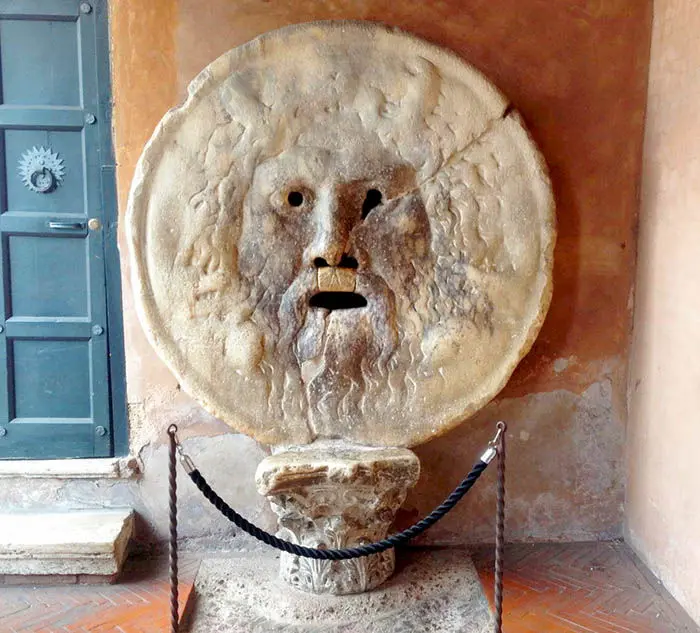
FORUM BOARIUM
The Forum Boarium was an area located on the banks of the Tiber River in which an animal market was held in ancient Rome. It houses the Republican temples of Hercules and Portuno, which were built during the 2nd century BC. Both have been preserved in good condition because they were consecrated as Christian churches during the medieval era. With the audioguide (audioguides), you can see the Temple of Portuno which is dedicated to the god of rivers and harbors.

CIRCUS MAXIMUS
Next stop of our audio guide (audio guides), the Circus Maximus, located between the Aventino and Palatino hills, was a long enclosure with space for 300,000 spectators. The sand track was 600 meters long and 225 meters wide.
It was here that public games were held. During horse-drawn cart races, participants had to circle the Circus Maximus seven times. Large bets were made, and the winner received an elaborate prize, or freedom if he was a slave.
There were also equestrian shows, one of which is known as "Ludus Troianus," which was a large scale battle simulation carried out by young aristocrats. It also hosted running races on foot which lasted several hours.
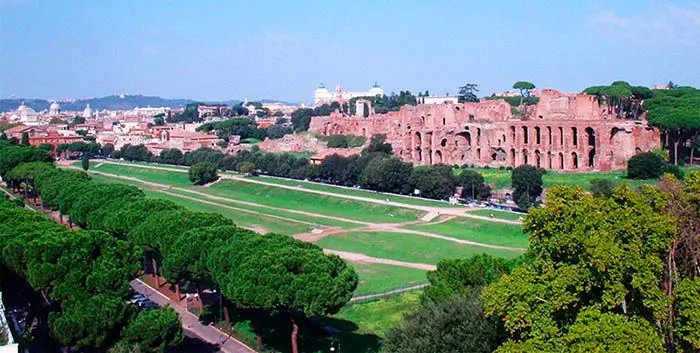
THE BATHS OF CARACALLA
Built under the rule of Emperor Caracalla between 212 and 216, these were one of the largest and most beautiful ancient thermal centers. The complex was covered in marble and decorated with precious artworks.
Within them, citizens had access to public baths, a gym, a library, and gardens to maintain good hygiene, relax, enhance their social relations or worship the god Mithra and other pagan deities.
Slaves would fuel wood-fired ovens to heat the water, the floors and the walls of the bathhouse. Effective water supply and drainage systems were also put to use.
The thermal baths stopped being used in 537 when the aqueducts that supplied water to the city were destroyed by the barbarians.
The audioguide (audioguides) leads us now to the catacombs.
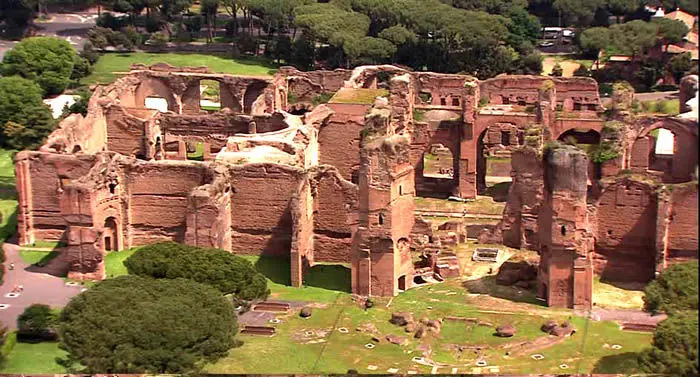
THE CATACOMBS OF ROME
The catacombs are underground galleries that were used as a burial place for pagans, Jews, and the first Christians. Excavation began in the 2nd century and it was used for 300 years.
Roman law of the time prohibited the burial of the deceased inside the city. In addition, it persecuted the Christian religion.
The Christians did not accept the pagan custom of incinerating the bodies of their deceased so they decided to create these vast underground cemeteries, which were the perfect burial grounds that allowed the free use of their own religious symbology.
Due to the high infant mortality rate at the time, there are numerous spaces for babies. Other spaces are larger pits in which the whole family was buried.
With the signing of the Edict of Milan in 313, Christian persecution ceased. This allowed them to begin building churches and acquire land without fear of confiscation. Nevertheless, they continued using the catacombs as a cemetery until the 5th century.
Many catacombs suffered continuous looting during the invasion of the barbarians in the 8th century. Consequently, the popes relocated the preserved relics to the churches of the city. At present, only five catacombs are open to the public: San Sebastián, San Calixto, Domitila, Priscilla and Santa Inés. You can visit them with the audioguide (audioguides).
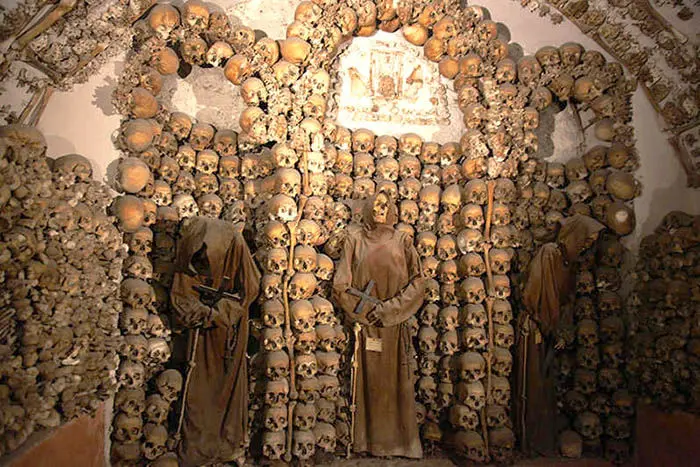
BASILICA OF SAINT PAUL OUTSIDE THE WALLS
Erected in the 4th century AD, this basilica serves as the burial ground of the Apostle Saint Paul, which is located under the main altar. You can see it with the audioguide (audioguides).
After the execution of the apostle in the first century AD, his followers created a sanctuary on the tomb. In the year 324, a small church was built, while a larger building was later constructed in 386.
It has a 150-column atrium covered by a golden mosaic that reflects the sun's rays. In the center of the courtyard is a statue of Saint Paul.
A fire in 1823 damaged the building, except for the sanctuary of 1208. However, the Basilica was rebuilt to its former glory using elements that had been saved from the fire.
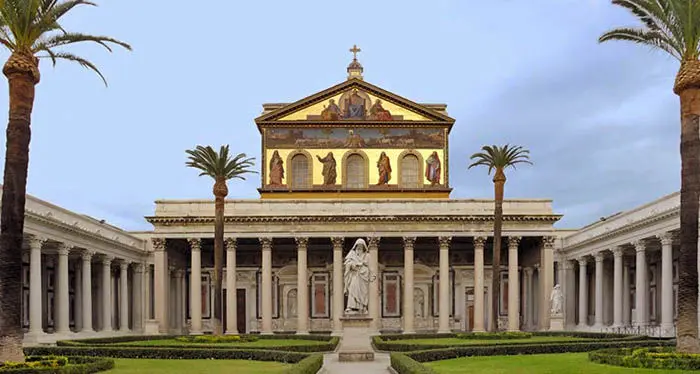
THE TRASTEVERE
Trastevere is a Roman neighborhood with narrow cobbled streets and a calm and bohemian air.
A highlight is the Piazza di Santa Maria, a favorite meeting place and the location of the Basilica of Santa Maria.
The neighborhood is home to medieval churches, boutique craft stores and a wide range of restaurants from typical Italian taverns to modern international cuisine that you can discover with the audioguide (audioguides).
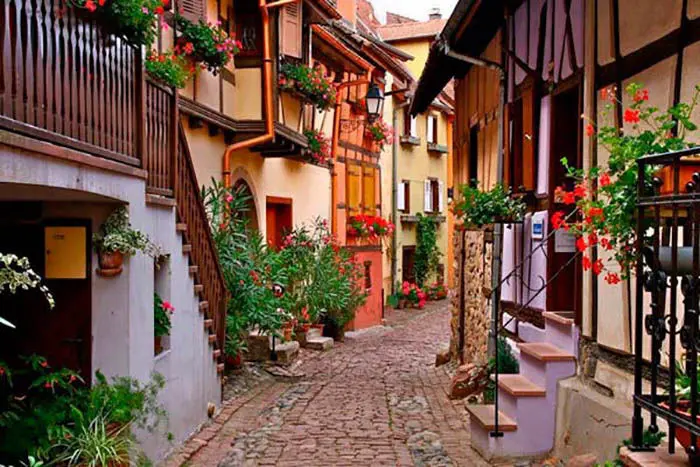
GIANICOLO
Gianicolo, the eighth hill of Rome, was the scene of a battle in which Garibaldi repelled an attack from the French. The top of the hill is full of sculptures in his honor.
One of the buildings we find here with the audioguide (audioguides) is the church of San Pietro in Montorio, the courtyard of which hosts a small temple erected on the spot where Saint Peter was crucified.
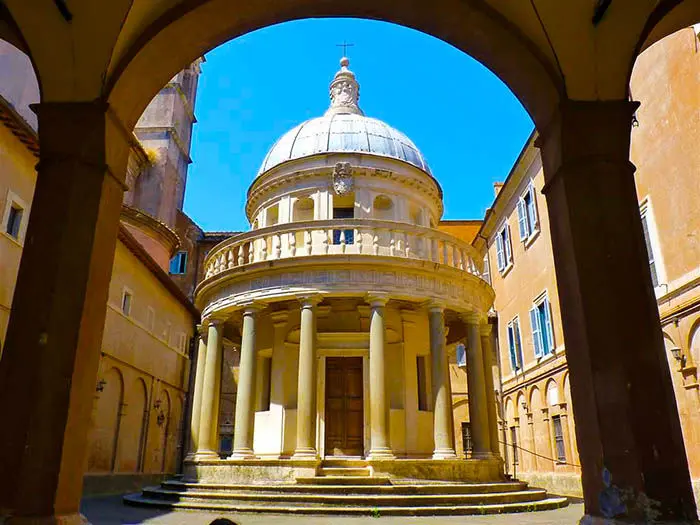
Audio guide devices, Multimedia audio guides,
Audio guide GPS tourist bus-train, charging bases and accessories.
Group guidance systems, headsets, charging cases, tour guide systems accessories.
Audioguides available from mobile devices, web App, downloadable App from Google Store.
Audioguides in several languages, translations, voiceovers. Audio descriptions, signoguides, visual contents for audioguides. 3D Reality.